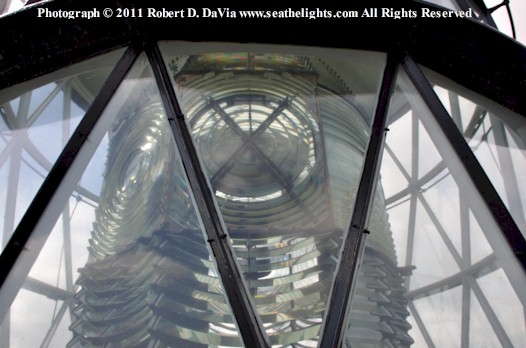JUPITER INLET LIGHTHOUSE

First lit on July 10, 1860, the 108-foot tower has brick, double masonry walls. The outer wall is conical, tapering from 31-1/2 inches (8 bricks thick) at the ground to 18-inches (3 bricks thick) at the base of the lantern. The cylindrical inner wall is 2-bricks thick from top to bottom. The circumference at the base is about 65-feet; at the top about 43-feet. There are 105 cast iron stairs spiraling counterclockwise around a central iron column, with three landings.

The tower is located atop a 48-foot hill, a Native American shell mound, which gives a height of 156-feet above sea level. The focal plane, the level at which the light is emitted, is 146-feet.

The jewel of the tower, its magnificent First Order Fresnel Lens, was manufactured in Paris by Henry-Lepaute, and is believed to be the oldest existing First Order Fresnel Lens in Florida. It contains 4 bulls eye flash panels, and is lit by a 1,000 watt, 120 volt, GE quartz-iodine bulb. Its identical spare will rotate into place if the first bulb burns out, by means of an automatic bulb changer. The range of the light, how far it can be seen at sea, is 24 miles. The light was electrified in 1928, when a 1/3 horsepower motor was installed to rotate the lens carriage. On June 8, 1987, the light was automated. A photoelectric cell turns the bulb and motor on when the sun sets, and off when the sun rises.

Looking up, inside the First Order Fresnel Lens
The tower's daymark is red with black lantern. For its flash characteristic, it flashes 1.2 seconds, eclipses (darkens) 6.6 seconds, flashes 1.2 seconds, eclipses 21 seconds, and repeats the cycle.

The lens from the Gallery Deck

The lens, from the Gallery Deck. This Bulls-eye Lens has two bronze crossbars
holding it in place, due to a hurricane that blew the lens out in 1928.

Captain Thomas Twiner, June 12, 1860 – December 13, 1861
Captain Joseph F. Papy, January 1, 1861 – August 1861
Captain William B. Davis 1866-1867
Captain James Arango Armour, assistant keeper 1866-1868; head keeper 1868-1908
Hannibal D Pierce, assistant 1872
Charles Carlin, assistant 1872
Melville Spencer, assistant 1881-1884
Dwight Allen, assistant; Captain Joseph Wells, head 1908-1918
Captain Thomas Knight, a few months in 1918
Captain Charles Seabrook, head 1919-1947
Raymond C Phillips, head keeper for 3 years 1950s-1960s


History Time Line
| Year | Event |
| 1838 | After the Battle of Loxahatchee, the Army created the Fort Jupiter Reservation, which included the land on which the lighthouse stands. |
| 1853 | Congress appropriated $35,000 for a Lighthouse in Jupiter. |
| 1854 | President Franklin Pierce signed the order to set aside a 61.5-acre site on the Fort Jupiter Reservation for a lighthouse. Lieutenant George Gordon Meade visited the site and submitted a design for a lighthouse. |
| 1855-58 | Construction was halted by Seminole attacks and later because the workmen were plagued by mosquitoes, extreme heat, and diseases, which were called Jupiter Fever, most likely malaria or yellow feaver. |
| 1859 | The first Keepers' House was built and was 26' x 30'. The Head Keeper and two Assistant Keepers lived here with their families and shared an outdoor kitchen. |
| 1860 | Light was lit for the first time on July 10. |
| 1861 | Three Confederate sympathizers removed enough of the apparatus to extinguish the light for the duration of the Civil War. |
| 1866 | Light was relit on June 28. |
| 1875 | A kitchen building was added to the Keepers' House. |
| 1883 | A two-story dwelling was built to accommodate the two Assistant Keepers and the old house was renovated for the Head Keeper. |
| 1886 | Kerosene replaced the original fuel, which was lard oil. |
| 1905 | The Navy establishes a radio station at the site. |
| 1910 | The tower was painted red. During the previous 50 years the bricks were never painted. |
| 1921 | Palm Beach County moved the mouth of the inlet 1,200 feet north. The tower, originally 3/4 of a mile inland, stands 1/2 mile from the Atlantic Ocean. |
| 1927 | A fire destroyed the original Keepers' House |
| 1928 | The worst hurricane on record blew out one of the bull's-eye lenses. The lens was reassembled and held in place by two bronze crossbars. |
| 1929 | The Navy acquired 8.4 acres of the Jupiter Lighthouse reservation and started to broadcast weather information and monitor ship-to-shore and aircraft distress calls. |
| 1939 | US Coast Guard took over the operation of this lighthouse and all US Lighthouses. |
| 1942 | The Marines arrived to protect the Navy's radio station. |
| 1950s | The Air Force set up and operated the first missile tracking station south of Cape Canaveral while the Army handled supplies and maintenance. |
| 1954 | Robert G. Denaro (Air Force) was stationed in Jupiter at the Jupiter Auxiliary Air Force Base in 1954 to clean up and close down Air Force operations. |
| 1959 | The Keepers' Houses were demolished. |
| 1973 | The Lighthouse was placed on the National Register of Historic Places. |
| 1985 | The archaeological site was placed on the National Register of Historic Places. |
| 1994 | The lighthouse was open to public tours administered by the Loxahatchee River Historical Society, formerly the Florida History Center & Museum. |
| 2000 | Lighthouse was restored by a grant in excess of $858,000 administered by the Loxahatchee River Historical Society (LRHS). |
| 2006 | Jupiter Inlet Lighthouse and Museum opened in December & operated by LRHS. |
Above information taken from brochures obtained at the Jupiter Inlet Lighthouse & Museum.


